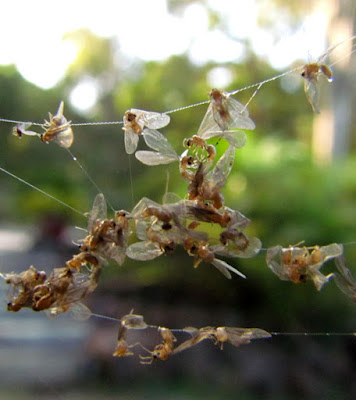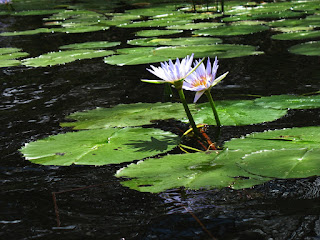Doing some tidying up of one of our wattles and found a group of "Earth Stars" in the leaf litter. One of the puffball type of fungi, the earth stars get their common name from the splitting of the outer peridial wall into a star shape that surrounds the inner peridial wall that retains the typical puff shape.
I am fairly sure that this particular species is Geastrum triplex, as the third part of the reason for the name is the collar, that is very evident in the photo. Most of the stars were well past their best, as I suspect they have been out for a day or so and started to dry out, so I was pleased to find one that still looked quite good.
Tuesday, 27 March 2012
Friday, 23 March 2012
From little things big things grow
Quite a warm clear day brought out a couple of snakes; a green tree snake travelling along our decking rail and Di when checking for ripe passionfruit discovered a tiny Diamond Python Python spilotus spilotus curled around a stem, under the shelter of a leaf. This youngster could not have been long out of the egg as it looked to be only about 200mm long (although it was all curled up so can't be certain) and its head was about a little fingernail size. It was in a difficult position to get a good photo so took one with available light and adjusted contrast on the PC and then took one with fill in flash.
Big colour difference due to the green light through the leaves without the flash and then the true colours of the juvenile snake with flash. As a contrast as I was working in the orchard a couple of days ago I found a large Diamond Python had made a daybed in the high branches of a Strawberry Guava bush and it looked to be at least 1800mm long based on the thickness and the mass it took up in the bush.
Big colour difference due to the green light through the leaves without the flash and then the true colours of the juvenile snake with flash. As a contrast as I was working in the orchard a couple of days ago I found a large Diamond Python had made a daybed in the high branches of a Strawberry Guava bush and it looked to be at least 1800mm long based on the thickness and the mass it took up in the bush.
Thursday, 22 March 2012
Bycatch
We often hear of the unfortunate fish that are unwanted but never the less end up caught in the fishing nets and today I saw nature's example as we have had millions of tiny ants on the wing and every spiders' net was thick with them and the spiders showing no interest at all.
However the same couldn't be said for the birds as they were having a feast, plucking the tiny ants off every twig and flower.
However the same couldn't be said for the birds as they were having a feast, plucking the tiny ants off every twig and flower.
Monday, 19 March 2012
A darter in the skippers
One of the largest family of butterflies in Australia are the Skippers (Hesperioidea) family, but then there are the subgroups, Awls, Flats, Skippers, Darts, Palm Darts, Swifts and Darters. I have taken photos of a few and find that they can be particularly difficult to identify from just the photo. Today I found a couple of obviously different species sunning on the same plant but one was off before I could get a shot but the other was a bit more obliging.
After comparing the photo to Skippers in my butterfly identification book and on a few websites I think it is a Pale Darter Telicota colon argeus which ranges across northern Australia and down as far as Sydney in open eucalyptus forests and grassy clearings on the edge of rain forest.
After comparing the photo to Skippers in my butterfly identification book and on a few websites I think it is a Pale Darter Telicota colon argeus which ranges across northern Australia and down as far as Sydney in open eucalyptus forests and grassy clearings on the edge of rain forest.
Friday, 16 March 2012
Attracted by the light
Today I was not expecting to have anything to post, as I didn't get a chance to go out with the camera, however tonight the light in the bathroom brought a moth for visit.
The butterfly house website enabled me to identify it as one of the Hawk moth family, SPHINGIDAE
Coequosa australasiae. It is quite a large moth with a wingspan of around 12cm and the caterpillars main food source are in the eucalyptus family.
Wednesday, 14 March 2012
Wonga off the ground
One of visitors that comes to feed on the seeds of grasses and trees that have fallen to the ground is the Wonga Pigeon Leucosarcia melanoleuca, a large bird but vary flighty and difficult to get near for a photo. However today I flushed one that made a short burst into a nearby tree and I did get a chance to get a shot.
They are found right down the east coast on the edge of rainforests and other dense forest areas. They were in large numbers but land clearing and shooting for the pot, by early settlers severely reduced the numbers, but they are gradually recovering throughout their range.
They are found right down the east coast on the edge of rainforests and other dense forest areas. They were in large numbers but land clearing and shooting for the pot, by early settlers severely reduced the numbers, but they are gradually recovering throughout their range.
Tuesday, 6 March 2012
A real gem
Some warm, drier weather has brought the snakes back out and yesterday I saw a Red-bellied Black snake and a Yellow-faced Whip snake. Today, late this afternoon a medium sized Diamond Python was soaking up the warmth on the pavers in the courtyard.
Monday, 5 March 2012
Wallaby portraits
The female Red-necked Wallaby that spends quite a bit of time around our house has this season's young in the pouch and this afternoon was content to keep on feeding as I took a few close-up photos of her and the youngster.
Saturday, 3 March 2012
Myall Lakes & river trip
Not too far from us is NSW's largest coastal fresh/brackish water lake system encompassed within the Myall Lakes national park. Covering over 10000 hectares and listed as a wetland of international significance it is one of the wonderful natural assets within our region. Last weekend a number of members of our local aquatic club went on our 4th annual trip from the top of the system at the tip of Myall Lake through the other lakes and into the Myall river travelling down to the town near where the river flows into Port Stephens. Our group consisted of some kayakers, sail/motor and motor boats even one steam powered boat travelling at a leisurely speed so the scenery along the way can be enjoyed. The total distance is some 60+km and we incorporate two overnight camps along the way where you can get close to the wildlife, savour campfire cooking and take in the sunsets.
 |
| Kookaburra hoping to get BBQ dinner |
 |
| The steamboat gets underway |
 |
| A patch of waterlilies calls for a photo stop |
Paddling on the way down didn't give me much of a chance to take photos particularly when we were heading down the river all the recent rain had added a reasonable flow downstream (made for good paddling). Arriving at Tea Gardens we get to have a hot shower, great fish and chips for dinner and a comfortable bed ready for the return trip. This is the easy part as the kayak is towed behind for the journey up river and I get a chance to get photos of the bird life along the way.
 | ||
| A pair of White-breasted sea eagles greet us as we enter the river; sighted 7 on the way back. |
 |
| A Darter or Snake-bird soaks up the sun |
 |
| one of the many pair of swans along the river's edge or feeding in the shallow lakes. |
 |
| Whistling Kites were numerous but difficult to get a decent photo. |
 |
| At our final campsite and the Black Ducks are used to getting fed or picking up scraps; so wandering around your feet when dinner is being prepared. |
Our last morning and awoken by a Dingo howling, right in the midst of our camp site, not an unusual occurrence, as irresponsible campers are prone to feed them or leave food out for them to scavenge.
Unlike the ones that I see at home this one did not move far away and just trotted ahead as I move to get a photo. Content to move along and spray his territory as he went, then lie down; get up and move on as I got closer.( DNA testing of dingos in this area place them at 70 to80% pure, domestic dog; the balance)
 |
| A male Orchard Butterfly at the spot where I photographed the Dingo |
 |
| A large Lace Monitor knows where it is safe to sleep out of danger from the Dingoes |
Labels:
Myall trip
Subscribe to:
Posts (Atom)
















